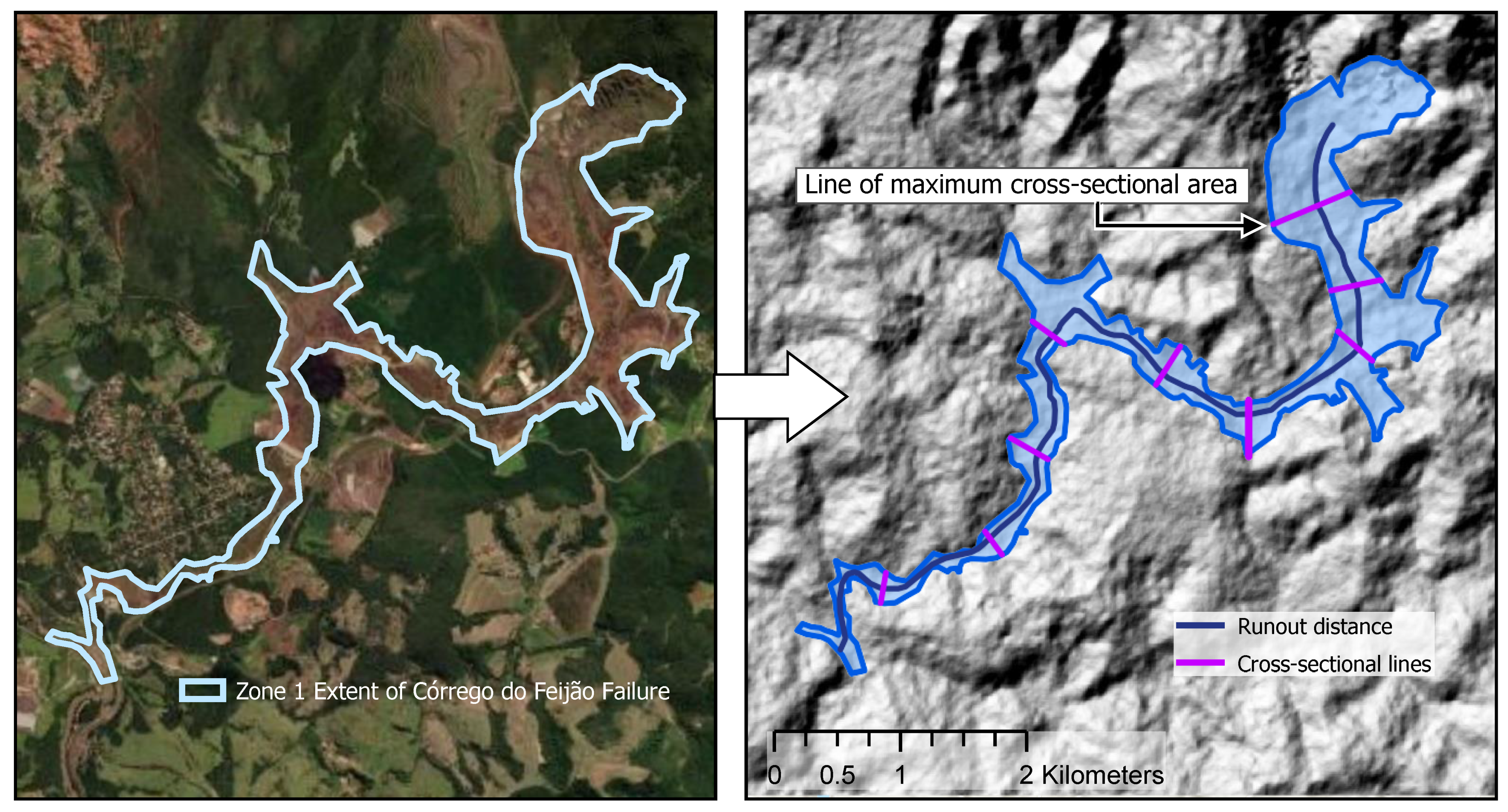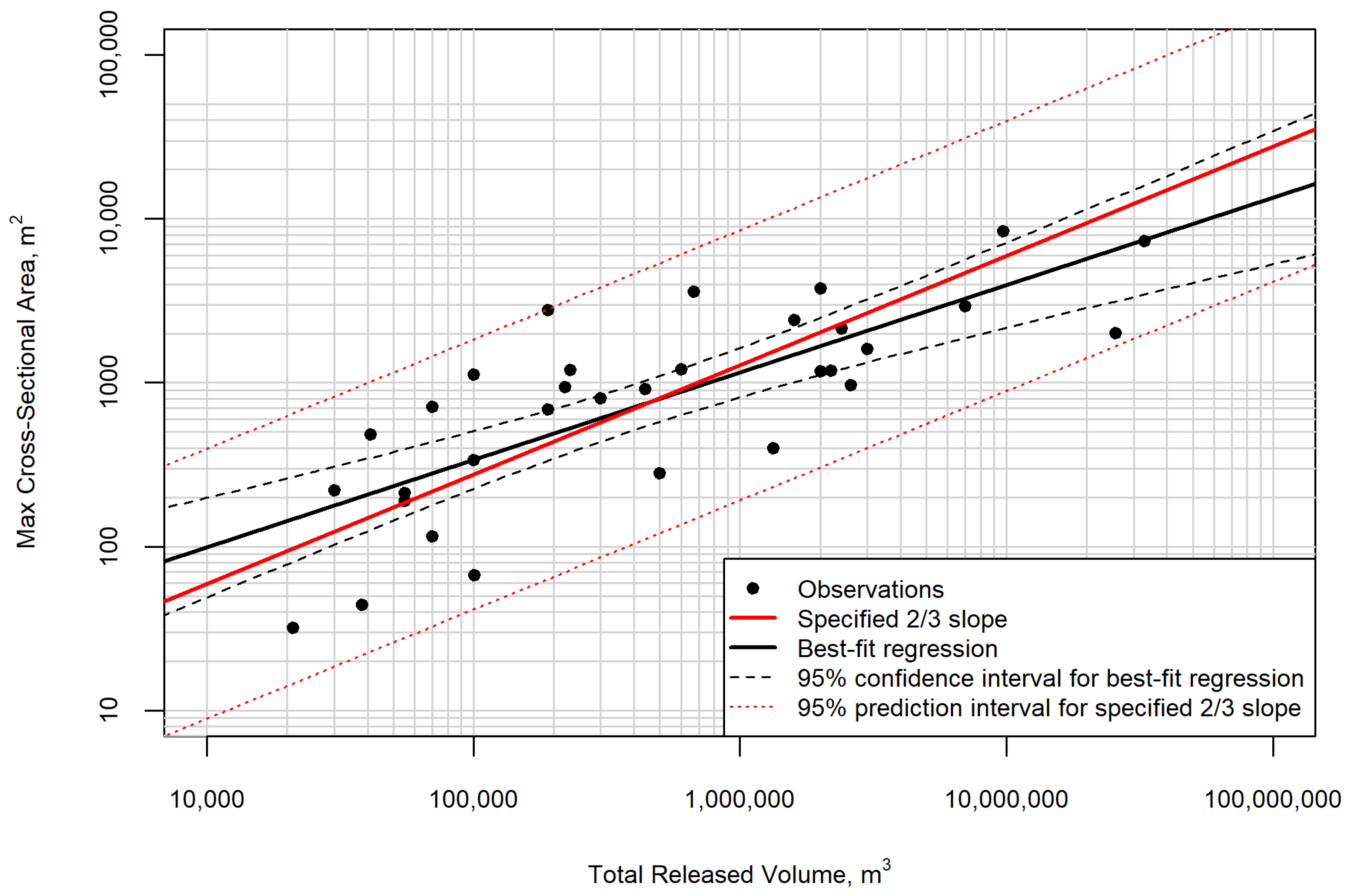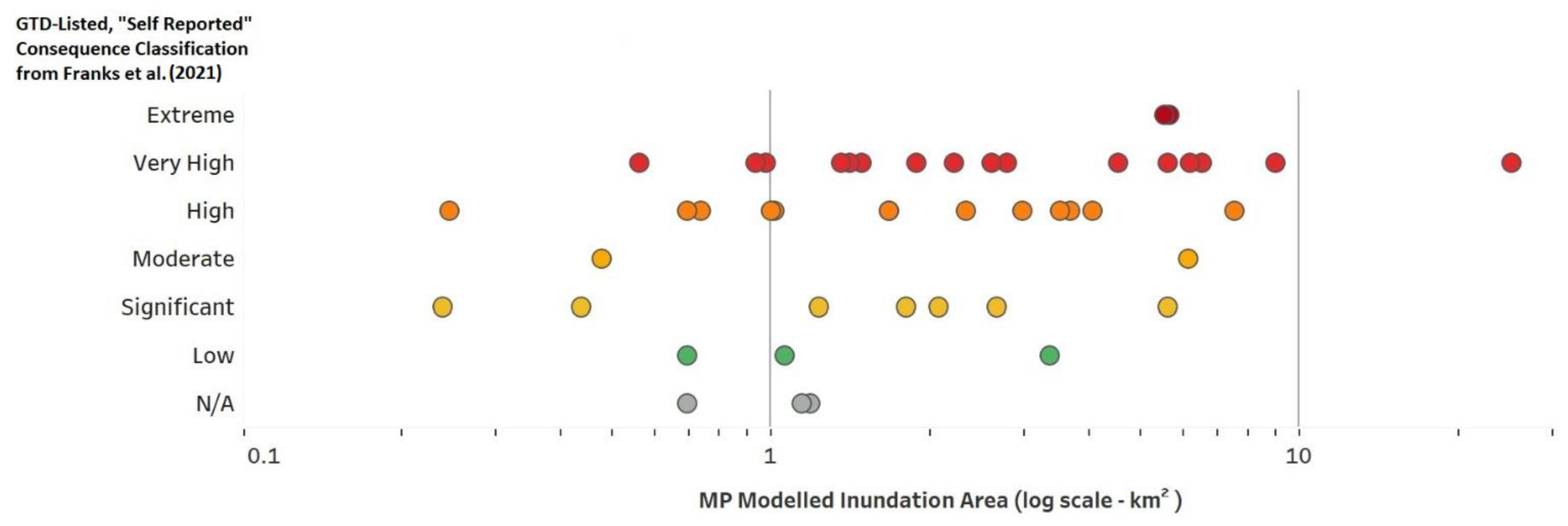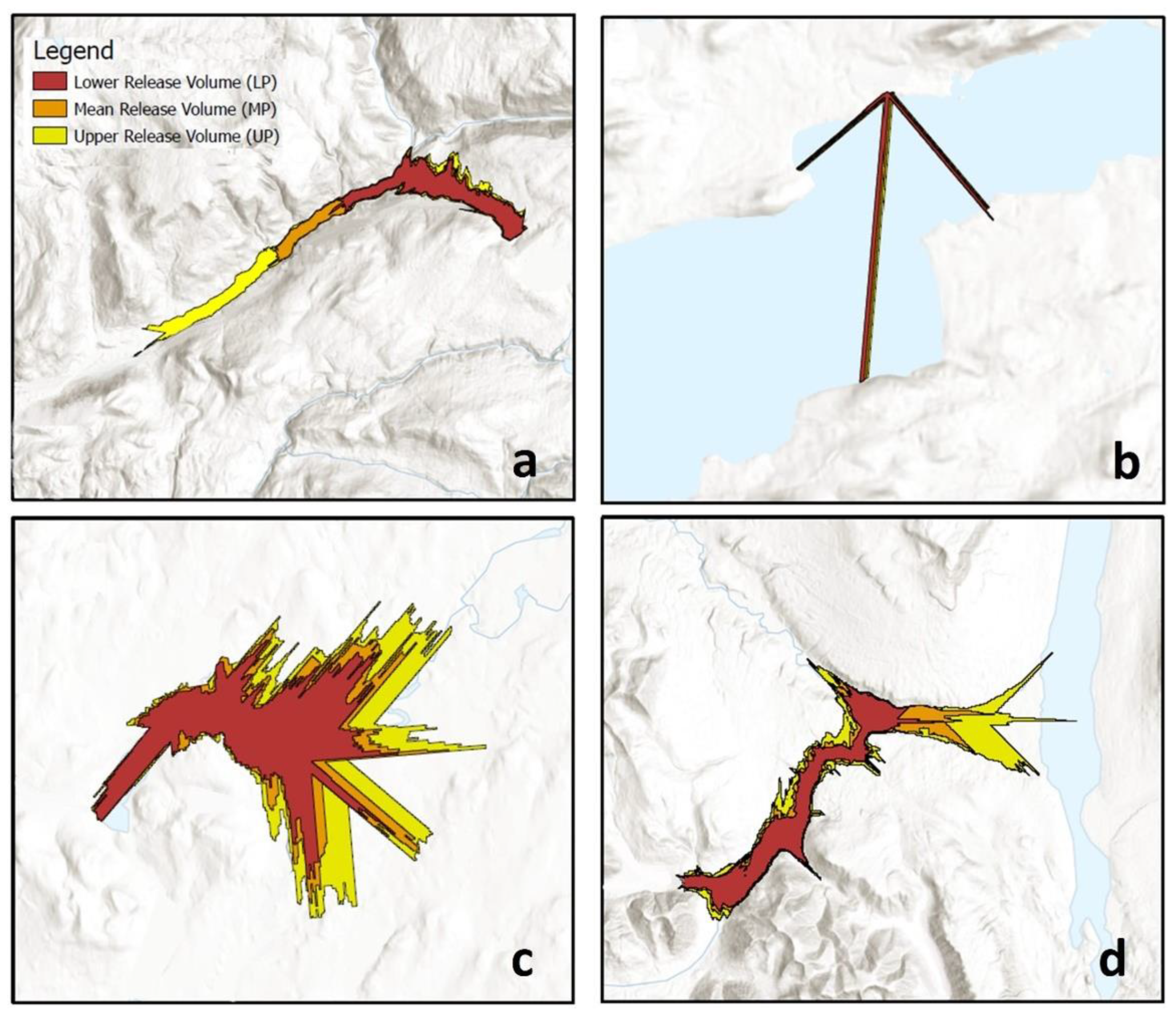The Development and Demonstration of a Semi-Automated Regional Hazard Mapping Tool for Tailings Storage Facility Failures
Abstract
:1. Introduction
1.1. Background
1.2. Scope and Objectives
2. Existing Empirical Tools for Modelling Tailings Flows
2.1. Empirical Relationships
2.2. LAHARZ
3. Methods
3.1. Calibration and Validation of Cross-Sectional Mobility Coefficient (cB)

| # | Event | Location | Year | Confined/ Unconfined | Total Released Volume (m3) | Zone 1-Tailings Runout Distance (m) | Zone 1-Inundation Area (m2) | Cross-Sectional Area (max) (m2) |
|---|---|---|---|---|---|---|---|---|
| 1 | Bellavista | Chile | 28 March 1965 | Unconfined | 55,000 | 1300 | 130,000 | 210 |
| 2 | Cerro Negro | Chile | 28 March 1965 | Unconfined | 70,000 | 3200 | 1,300,000 | 710 |
| 3 | El Cobre (New & Old Dams) | Chile | 28 March 1965 | Confined | 2,400,000 | 11,200 | 5,900,000 | 2100 |
| 4 | Los Maquis | Chile | 28 March 1965 | Confined | 21,000 | 1500 | 47,000 | 30 |
| 5 | Sgorigrad | Bulgaria | 1 May 1966 | Confined | 220,000 | 6000 | 400,000 | 940 |
| 6 | Certej | Romania | 30 October 1971 | Confined | 300,000 | 2300 | 380,000 | 810 |
| 7 | Bafokeng | South Africa | 11 November 1974 | Confined | 3,000,000 | 22,000 | 9,000,000 | 1600 |
| 8 | Stava | Italy | 19 July 1985 | Confined | 190,000 | 4200 | 500,000 | 2800 |
| 9 | Stancil | USA | 25 August 1989 | Unconfined | 38,000 | 100 | 7000 | 40 |
| 10 | Tapo Canyon | USA | 17 January 1994 | Confined | 55,000 | 730 | 30,000 | 190 |
| 11 | Merriespruit (Harmony) | South Africa | 22 February 1994 | Unconfined | 600,000 | 2200 | 900,000 | 1200 |
| 12 | Pinto Valley | USA | 22 October 1997 | Confined | 230,000 | 830 | 80,000 | 1200 |
| 13 | Los Frailes/Aznalcollar | Spain | 24 April 1998 | Unconfined | 7,000,000 | 29,000 | 16,000,000 | 2900 |
| 14 | Comurhex, Cogéma/Areva | France | 20 March 2004 | Unconfined | 30,000 | 700 | 70,000 | 220 |
| 15 | Mineracao (Rio Pomba) | Brazil | 10 January 2007 | Confined | 2,000,000 | 40,000 | 8,000,000 | 3800 |
| 16 | Xiangfen | China | 8 September 2008 | Unconfined | 190,000 | 2300 | 400,000 | 690 |
| 17 | Kingston fossil plant | USA | 22 December 2008 | Unconfined | 4,100,000 | 1400 | 800,000 | - |
| 18 | Karamken | Russia | 29 August 2009 | Confined | 2,200,000 | 2900 | 520,000 | 1200 |
| 19 | Las Palmas | Chile | 27 February 2010 | Unconfined | 100,000 | 550 | 80,000 | 340 |
| 20 | Ajka | Hungary | 4 October 2010 | Confined | 1,600,000 | 17,800 | 6,000,000 | 2400 |
| 21 | Kayakari | Japan | 11 March 2011 | Confined | 41,000 | 2000 | 150,000 | 480 |
| 22 | Gullbridge | Canada | 17 December 2012 | Unconfined | 100,500 | 500 | 44,000 | 70 |
| 23 | Obed Mountain | Canada | 31 October 2013 | Confined | 670,000 | 5100 | 1,000,000 | 3600 |
| 24 | Mount Polley | Canada | 4 August 2014 | Confined | 25,600,000 | 9000 | 2,000,000 | 2000 |
| 25 | Fundão | Brazil | 5 November 2015 | Confined | 33,000,000 | 99,000 | 21,000,000 | 7400 |
| 26 | Luoyang | China | 8 August 2016 | Confined | 2,000,000 | 2500 | 300,000 | 1200 |
| 27 | Tonglvshan | China | 12 March 2017 | Unconfined | 500,000 | 500 | 300,000 | 280 |
| 28 | Mishor Rotem | Israel | 30 June 2017 | Confined | 100,000 | 28,000 | 2,000,000 | 1100 |
| 29 | Jharsuguda (Vedanta) | India | 28 August 2017 | Unconfined | 2,600,000 | 640 | 500,000 | 970 |
| 30 | Cieneguita | Mexico | 4 June 2018 | Confined | 440,000 | 15,000 | 500,000 | 920 |
| 31 | Cadia | Australia | 9 March 2018 | Unconfined | 1,330,000 | 480 | 120,000 | 400 |
| 32 | Feijão | Brazil | 25 January 2019 | Confined | 9,650,000 | 9000 | 2,700,000 | 8400 |
| 33 | Cobriza | Peru | 10 July 2019 | Confined | 70,000 | 450 | 70,000 | 120 |
3.2. Development of the Semi-Automated LAHARZ-T Code
3.3. Demonstration of a LAHARZ-T Application for Regional Scale Analysis
3.3.1. Methodology for LAHARZ-T Regional Scale Analysis
3.3.2. LAHARZ-T Input Generation
3.3.3. Release Volume
4. Results
4.1. Model Calibration
4.2. Model Validation
4.3. Demonstration of the Semi-Automated LAHARZ-T Model for Regional Use: Canadian Application
5. Discussion
5.1. Implications
5.1.1. Implications for Portfolio-Level Modelling for Institutional Mining Investors
5.1.2. Implications of Regional-Level Scale Modelling for Policymakers
5.2. Limitations of LAHARZ-T
- The output of LAHARZ-T does not include flow evolution parameters such as flow velocity or accumulation thickness. In cases where flow depth and velocity are necessary for decision making such as in emergency planning, numerical models should be used.
- Field conditions related to the rheological properties of the tailings were not directly considered in the calibration of the mobility coefficients. Highly saturated tailings flows may not be adequately modelled using LAHARZ-T.
- The planimetric and cross-sectional mobility coefficients (cA and cB) represent a global sample of failures and are not further classified into coefficients based on downstream confinement (Table 1, Rana et al. [13]) This allows for the model to have a broader, multi-terrain application supporting regional or portfolio approaches. However, this may result in the model responding less accurately where flows are unconfined. As discussed in Rana et al. [13] and Ghahramani et al. [4], additional information on historical tailings flows are required to improve the relationship between inundation area and downstream confinement. As more data becomes available, the mobility coefficients can be further refined.
6. Conclusions
Author Contributions
Funding
Data Availability Statement
Acknowledgments
Conflicts of Interest
References
- Rana, N.M.; Ghahramani, N.; Evans, S.G.; Small, A.; Skermer, N.; McDougall, S.; Take, W.A. Global Magnitude-Frequency Statistics of the Failures and Impacts of Large Water-Retention Dams and Mine Tailings Impoundments. Earth-Sci. Rev. 2022, 232, 104144. [Google Scholar] [CrossRef]
- WISE. Chronology of Major Tailings Dam Failures. Available online: http://wise-uranium.org/mdaf.html (accessed on 6 July 2020).
- BC First Nations Energy & Mining Council. Uncertainty Upstream: Potential Threats from Tailings Facility Failures in Northern British Columbia; BC First Nations Energy & Mining Council: North Vancouver, BC, Canada, 2015.
- Ghahramani, N.; Mitchell, A.; Rana, N.M.; McDougall, S.; Evans, S.G.; Take, W.A. Tailings-Flow Runout Analysis: Examining the Applicability of a Semi-Physical Area–Volume Relationship Using a Novel Database. Nat. Hazards Earth Syst. Sci. 2020, 20, 3425–3438. [Google Scholar] [CrossRef]
- Rico, M.; Benito, G.; Díez-Herrero, A. Floods from Tailings Dam Failures. J. Hazard. Mater. 2008, 154, 79–87. [Google Scholar] [CrossRef] [PubMed]
- Santamarina, J.C.; Torres-Cruz, L.A.; Bachus, R.C. Why Coal Ash and Tailings Dam Disasters Occur. Science 2019, 364, 526–528. [Google Scholar] [CrossRef]
- Piciullo, L.; Storrøsten, E.B.; Liu, Z.; Nadim, F.; Lacasse, S. A New Look at the Statistics of Tailings Dam Failures. Eng. Geol. 2022, 303, 106657. [Google Scholar] [CrossRef]
- de Lima, R.E.; de Lima Picanço, J.; da Silva, A.F.; Acordes, F.A. An Anthropogenic Flow Type Gravitational Mass Movement: The Córrego Do Feijão Tailings Dam Disaster, Brumadinho, Brazil. Landslides 2020, 17, 2895–2906. [Google Scholar] [CrossRef]
- Hatje, V.; Pedreira, R.M.A.; De Rezende, C.E.; Schettini, C.A.F.; De Souza, G.C.; Marin, D.C.; Hackspacher, P.C. The Environmental Impacts of One of the Largest Tailing Dam Failures Worldwide. Sci. Rep. 2017, 7, 10706. [Google Scholar] [CrossRef]
- Morgenstern, N.R.; Vick, S.G.; Viotti, C.B.; Watts, B.D. Fundão Tailings Dam Review Panel Report on the Immediate Causes of the Failure of the Fundão Dam; Cleary Gottlieb Steen &Hamilton LLP: New York, NY, USA, 2016. [Google Scholar]
- Armstrong, M.; Petter, R.; Petter, C. Why Have so Many Tailings Dams Failed in Recent Years? Resour. Policy 2019, 63, 101412. [Google Scholar] [CrossRef]
- Schoenberger, E. Environmentally Sustainable Mining: The Case of Tailings Storage Facilities. Resour. Policy 2016, 49, 119–128. [Google Scholar] [CrossRef]
- Rana, N.M.; Ghahramani, N.; Evans, S.G.; McDougall, S.; Small, A.; Take, W.A. Catastrophic Mass Flows Resulting from Tailings Impoundment Failures. Eng. Geol. 2021, 292, 106262. [Google Scholar] [CrossRef]
- Ghahramani, N.; Chen, H.J.; Clohan, D.; Liu, S.; Llano-Serna, M.; Rana, N.M.; McDougall, S.; Evans, S.G.; Take, W.A. A Benchmarking Study of Four Numerical Runout Models for the Simulation of Tailings Flows. Sci. Total Environ. 2022, 827, 154245. [Google Scholar] [CrossRef] [PubMed]
- Iverson, R.M.; Schilling, S.P.; Vallance, J.W. Objective Delineation of Lahar-Inundation Hazard Zones. Bull. Geol. Soc. Am. 1998, 110, 972–984. [Google Scholar] [CrossRef]
- Rico, M.; Benito, G.; Salgueiro, A.R.; Díez-Herrero, A.; Pereira, H.G. Reported Tailings Dam Failures. A Review of the European Incidents in the Worldwide Context. J. Hazard. Mater. 2008, 152, 846–852. [Google Scholar] [CrossRef]
- Innis, S.; Kunz, N.C. The Role of Institutional Mining Investors in Driving Responsible Tailings Management. Extr. Ind. Soc. 2020, 7, 1377–1384. [Google Scholar] [CrossRef]
- Bonnafous, L.; Lall, U.; Siegel, J. A Water Risk Index for Portfolio Exposure to Climatic Extremes: Conceptualization and an Application to the Mining Industry. Hydrol. Earth Syst. Sci. 2016, 21, 2075–2106. [Google Scholar] [CrossRef]
- Siegel, J.; Concha Larrauri, P.; Bonnafous, L.; Lall, U. Multi-Dimensional and Interacting Water and Climate Risks and Pricing Them in the Industry Context. In Water Risk and Its Impact on the Financial Markets and Society: New Developments in Risk Assessment and Management; Walker, T., Gramlich, D., Vico, K., Dumont-Bergeron, A., Eds.; Springer International Publishing: Cham, Switzerland, 2021; pp. 303–327. [Google Scholar] [CrossRef]
- British Columbia Mines Audit Unit. Audit of Code Requirements for Tailings Storage Facilities; British Columbia Mines Audit Unit: Victoria, BC, Canada, 2021.
- Bellringer, C. An Audit of Compliance and Enforcement of the Mining Sector; Auditor General of British Columbia: Victoria, BC, Canada, 2016.
- GRID-Arenal. Global Tailings Portal. Available online: https://tailing.grida.no/ (accessed on 24 April 2020).
- Concha Larrauri, P.; Lall, U. Tailings Dams Failures: Updated Statistical Model for Discharge Volume and Runout. Environments 2018, 5, 28. [Google Scholar] [CrossRef]
- Innis, S.; Ghahramani, N.; Rana, N.M.; McDougall, S.; Evans, S.G.; Take, W.A.; Kunz, N.C. Automated Hazard Mapping of Tailings Storage Facility Failures. In Proceedings of the Tailings and Mine Waste 2020, Virtual Event, 15–18 November 2020; pp. 661–670. [Google Scholar]
- Small, A.; James, M.; Al-mamun, M. Advancing the State of Practice for Tailings Dam Breach Assessment Using Empirical Correlations. In Canadian Dam Association Annual Conference; CDA 2017 Annual Conference: Kelowna, BC, Canada, 2017; p. 17. [Google Scholar]
- Davies, T.R.H. Spreading of Rock Avalanche Debris by Mechanical Fluidization. Rock Mech. 1982, 15, 9–24. [Google Scholar] [CrossRef]
- Hungr, O. Dynamics of Rock Avalanches and Other Types of Slope Movements. Ph.D. Thesis, University of Alberta, Edmonton, AB, Canada, 1981. [Google Scholar]
- Hungr, O.; Evans, S. The Failure Behaviour of Large Rockslides in Mountainous Regions; Geological Survey of Canada: Ottawa, ON, Canada, 1993. [Google Scholar]
- Li, T. A Mathematical Model for Predicting the Extend of a Major Rockfall. Z. Geomorphol. 1983, 27, 473–482. [Google Scholar]
- Schilling, S. Laharz_py: GIS Tools for Automated Mapping of Lahar Inundation Hazard Zones. Available online: https://pubs.usgs.gov/of/2014/1073/ (accessed on 7 July 2020).
- Griswold, J.; Iverson, R. Mobility Statistics and Automated Hazard Mapping for Debris Flows and Rock Avalanches. U.S. Geol. Surv. Sci. Investig. Rep. 2007-5276 2008, 1–67. [Google Scholar] [CrossRef]
- Bernard, D.; Trousil, E.; Santi, P. Estimation of Inundation Areas of Post-Wildfire Debris Flows in Southern California USA. Eng. Geol. 2021, 285, 105991. [Google Scholar] [CrossRef]
- Innis, S.; Lynd, J.; Reemeyer, L.; Kunz, N. Regional Perspectives and Trends of Land at Risk from Tailings Storage Facility Failures. In Proceedings of Tailings and Mine Waste 2021; University of Alberta, Department of Civil & Environmental Engineering: Edmonton, AB, Canada, 2021; pp. 333–342. [Google Scholar]
- Dedring, T.; Graw, V.; Thygesen, K.; Rienow, A. Validation of an Empirical Model with Risk Assessment Functionalities to Simulate and Evaluate the Tailings Dam Failure in Brumadinho. Sustainability 2022, 14, 6681. [Google Scholar] [CrossRef]
- Earth Resources Observation and Science (EROS) Center. EROS Archive—Digital Elevation—Shuttle Radar Topography Mission (SRTM) 1 Arc-Second Global. Available online: https://doi.org/10.5066/F7PR7TFT (accessed on 7 July 2020).
- Hawkins, D.M.; Basak, S.C.; Mills, D. Assessing Model Fit by Cross-Validation. J. Chem. Inf. Comput. Sci. 2003, 43, 579–586. [Google Scholar] [CrossRef]
- © JAXA/METI. ALOS PALSAR L 1.0. 2007. Available online: https://asf.alaska.edu/ (accessed on 4 January 2022). [CrossRef]
- Franks, D.M.; Stringer, M.; Cruz, L.A.T.; Baker, E.; Valenta, R.; Thygesen, K.; Matthews, A.; Howchin, J.; Barrie, S. Tailings Facility Disclosures Reveal Stability Risks. Sci. Rep. 2021, 11, 5353. [Google Scholar] [CrossRef] [PubMed]
- Hjorth, P.; Bengtsson, L. Large Dams, Statistics and Critical Review. In Encyclopedia of Earth Sciences Series; Springer: Dordrecht, The Netherlands, 2012; pp. 475–479. [Google Scholar] [CrossRef]
- Muñoz-Salinas, E.; Castillo-Rodríguez, M.; Manea, V.; Manea, M.; Palacios, D. Lahar Flow Simulations Using LAHARZ Program: Application for the Popocatépetl Volcano, Mexico. J. Volcanol. Geotherm. Res. 2009, 182, 13–22. [Google Scholar] [CrossRef]
- Clarkson, L.; Williams, D. An Overview of Conventional Tailings Dam Geotechnical Failure Mechanisms. Min. Metall. Explor. 2021, 38, 1305–1328. [Google Scholar] [CrossRef]
- Quelopana, H. Released Volume Estimation for Dam Break Analysis. In Proceedings of the 6th International Seminar in Tailings Management, Santiago, Chile, 9 July 2019. [Google Scholar]
- CDA. Dam Safety Guidelines; CDA: Varsity Lakes, QLD, Australia, 2013. [Google Scholar]
- Water File—Lakes and Rivers (polygons)—2011 Census—Open Government Portal. Available online: https://open.canada.ca/data/en/dataset/448ec403-6635-456b-8ced-d3ac24143add (accessed on 28 April 2022).
- Owen, J.R.; Kemp, D.; Lèbre; Svobodova, K.; Pérez Murillo, G. Catastrophic Tailings Dam Failures and Disaster Risk Disclosure. Int. J. Disaster Risk Reduct. 2019, 42, 101361. [Google Scholar] [CrossRef]
- Barrie, S.; Baker, E.; Howchin, J.; Matthews, A. Chapter 16: Investor Mining and Tailings Safety Initiative; Global Tailings Review: London, UK, 2020. [Google Scholar]
- New Global Investor Initiative, Mining 2030, to Tackle Eight Systemic Issues Challenging the Mining Sector and the Low Carbon Transition. Available online: https://www.churchofengland.org/media-and-news/press-releases/new-global-investor-initiative-mining-2030-tackle-eight-systemic (accessed on 29 March 2022).
- De La Orden, R.; De Calonje, I. Sustainability-Linked Finance-Mobilizing Capital for Sustainability in Emerging Markets; International Finance Corporation (IFC): Washington, DC, USA, 2022. [Google Scholar]
- Mapping Miners’ Exposure to Political and Regulatory Risks. Available online: https://www.fitchsolutions.com/mining/mapping-miners-exposure-political-and-regulatory-risks-02-09-2018 (accessed on 29 March 2022).
- Gilsbach, L.; Schütte, P.; Franken, G. Applying Water Risk Assessment Methods in Mining: Current Challenges and Opportunities. Water Resour. Ind. 2019, 22, 100118. [Google Scholar] [CrossRef]
- South Pole. Methodology for Water Risk Assessments of Equity Portfolios Commissioned by the Swiss Federal Office for the Environment (FOEN); South Pole: Zürich, Switzerland, 2020. [Google Scholar]
- How Do Investors Use Water Risk Data?|Engagement Guide|PRI. Available online: https://www.unpri.org/environmental-issues/how-do-investors-use-water-risk-data/2803.article (accessed on 29 March 2022).
- Chovan, K.M.; Julien, M.R.; Ingabire, E.; James, M.; Lépine, T.; Lavoie, P.; Chovan, K.M.; Eng, P. A Risk Assessment Tool for Tailings Storage Facilities. Can. Geotech. J. 2021, 58, 1898–1914. [Google Scholar] [CrossRef]
- Makinen, V.; Oksanen, J.; Sarjakoski, T. Creating Visually Consistent DEMs over Water Bodies Using Laser Scanning Data. In Proceedings of the AGILE 2019, Limassol, Cyprus, 17–20 June 2019. [Google Scholar]
- Höfle, B.; Vetter, M.; Pfeifer, N.; Mandlburger, G.; Stötter, J. Water Surface Mapping from Airborne Laser Scanning Using Signal Intensity and Elevation Data. Earth Surf. Process. Landf. 2009, 34, 1635–1649. [Google Scholar] [CrossRef]
- Berti, M.; Simoni, A. Prediction of Debris Flow Inundation Areas Using Empirical Mobility Relationships. Geomorphology 2007, 90, 144–161. [Google Scholar] [CrossRef]
- Magirl, C.S.; Griffiths, P.G.; Webb, R.H. Analyzing Debris Flows with the Statistically Calibrated Empirical Model LAHARZ in Southeastern Arizona, USA. Geomorphology 2010, 119, 111–124. [Google Scholar] [CrossRef]
- Stevens, N.F.; Manville, V.; Heron, D.W. The Sensitivity of a Volcanic Flow Model to Digital Elevation Model Accuracy: Experiments with Digitised Map Contours and Interferometric SAR at Ruapehu and Taranaki Volcanoes, New Zealand. J. Volcanol. Geotherm. Res. 2003, 119, 89–105. [Google Scholar] [CrossRef]





| Output Parameter | Units | Empirical Relationship | R2 | n | Source |
|---|---|---|---|---|---|
| Total release volume | M m3 | VF = 0.354 VT 1.01 | 0.86 | 22 | Rico et al. [5] |
| Maximum runout distance | m | Dmax = 14.45 VF 0.76 | 0.56 | 23 | Rico et al. [5] |
| Maximum runout distance | m | Dmax = 0.05 h1.41 | 0.16 | 25 | Rico et al. [5] |
| Maximum runout distance | m | Dmax = 1.61 (h VF)0.66 | 0.57 | 24 | Rico et al. [5] |
| Total release volume * | M m3 | VF = 0.332 VT 0.95 | 0.89 | 29 | Concha Larrauri & Lall [23] |
| Maximum runout distance | km | Dmax = 3.04 HF 0.545 | 0.53 | 29 | Concha Larrauri & Lall [23] |
| Zone 1 planimetric inundation area * | m2 | A = 80 VF 2/3 | 0.57 | 33 | Ghahramani et al. [4] |
| Zone 1 planimetric inundation area: channelized flow | m2 | A = 14 VF 0.81 | 0.72 | 22 | Rana et al. [13] |
| Zone 1 runout distance: channelized flow | m | D = 17 VF 0.44 | 0.47 | 24 | Rana et al. [13] |
| Zone 1 planimetric inundation area: unconfined flow Zone 1 runout distance: unconfined flow | m2 | A = 72 VF 0.64 | 0.36 | 14 | Rana et al. [13] |
| m | D = 33 VF 0.27 | 0.13 | 14 | Rana et al. [13] | |
| Total release volume | M m3 | R = 0.214 V 0.35 | 0.59 | 70 | Piciullo et al. [7] |
| Flow Type | Planimetric c Coefficient, cA | Cross-Sectional c Coefficient, cB | Source |
|---|---|---|---|
| Tailings flows | 80 | * | Ghahramani et al. [4]; * current study. |
| Lahars | 200 | 0.05 | Iverson et al. [15] |
| Debris Flows | 20 | 0.1 | Griswold and Iverson [31] |
| Rock Avalanches | 20 | 0.2 | Griswold and Iverson [31] |
| Parameter | Best-Fit Regression | Specified 2/3 Slope |
|---|---|---|
| Slope (α) | 0.53 | 0.67 |
| Intercept of line at log V = 0 (Log(β)) | −0.14 | −0.89 |
| β | 0.72 | 0.1 |
| Number of data, n | 32 | 32 |
| Standard error of model, σ | 0.39 | 0.40 |
| Standard error of volume coefficient | 0.08 | NA |
| Standard error of intercept | 0.46 | 0.07 |
| Coefficient of determination, R2 | 0.58 | 0.56 |
| Case | Failure | Confinement | Exceedance |
|---|---|---|---|
| P. 2 | Cerro Negro | Unconfined | Area |
| P. 9 | Stancil | Unconfined | Area |
| P. 20 | Ajka | Channelized | Runout distance |
| P. 28 | Mishor Rotem | Channelized | Area/Runout distance |
| P. 31 | Cadia | Unconfined | Runout distance |
Publisher’s Note: MDPI stays neutral with regard to jurisdictional claims in published maps and institutional affiliations. |
© 2022 by the authors. Licensee MDPI, Basel, Switzerland. This article is an open access article distributed under the terms and conditions of the Creative Commons Attribution (CC BY) license (https://creativecommons.org/licenses/by/4.0/).
Share and Cite
Innis, S.; Ghahramani, N.; Rana, N.; McDougall, S.; Evans, S.G.; Take, W.A.; Kunz, N.C. The Development and Demonstration of a Semi-Automated Regional Hazard Mapping Tool for Tailings Storage Facility Failures. Resources 2022, 11, 82. https://doi.org/10.3390/resources11100082
Innis S, Ghahramani N, Rana N, McDougall S, Evans SG, Take WA, Kunz NC. The Development and Demonstration of a Semi-Automated Regional Hazard Mapping Tool for Tailings Storage Facility Failures. Resources. 2022; 11(10):82. https://doi.org/10.3390/resources11100082
Chicago/Turabian StyleInnis, Sally, Negar Ghahramani, Nahyan Rana, Scott McDougall, Stephen G. Evans, W. Andy Take, and Nadja C. Kunz. 2022. "The Development and Demonstration of a Semi-Automated Regional Hazard Mapping Tool for Tailings Storage Facility Failures" Resources 11, no. 10: 82. https://doi.org/10.3390/resources11100082






